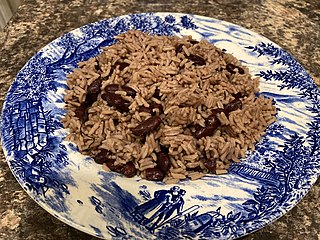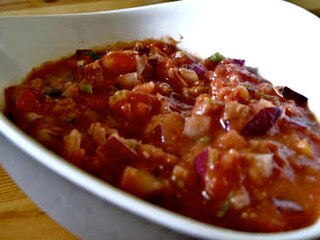Related Research Articles

The genus Cajanus is a member of the plant family Fabaceae. There are 37 species, mainly distributed across Africa, Asia and Australasia.

Rice and beans, or beans and rice, is a category of dishes from many cultures around the world, whereby the staple foods of rice and beans are combined in some manner. The grain and legume combination provides several important nutrients and many calories, and both foods are widely available. The beans are usually seasoned, while the rice may be plain or seasoned. The two components may be mixed together, separated on the plate, or served separately.

Hoppin' John, also known as Carolina peas and rice, is a peas and rice dish served in the Southern United States. It is made with cowpeas and rice, chopped onion, and sliced bacon, seasoned with salt. Some recipes use ham hock, fatback, country sausage, or smoked turkey parts instead of bacon. A few use green peppers or vinegar and spices. Smaller than black-eyed peas, field peas are used in the South Carolina Lowcountry and coastal Georgia; black-eyed peas are the norm elsewhere.
Tandur is a town in Vikarabad district in the Indian State of Telangana. It is a municipality consisting of 36 wards, as well as the headquarters of Tandur Mandal in the Tandur Revenue Division. It is known for its production of Limestone, Cement, and Redgram . Drinking water is sourced from the River Kagna, a tributary of the Bhima River, which is 4 km from the town. The country's famous Tandur Redgram has been awarded the Geographical Indication (GI) by The Central Department of Commerce and Industry.

Split peas are an agricultural or culinary preparation consisting of the dried, peeled and split seeds of Pisum sativum, the pea.
Black peas, also called parched peas or dapple peas, are cooked purple podded peas. They are a traditional Lancashire dish usually served with lashings of malt vinegar, and traditionally on or around Bonfire Night. The dish is popular in Bury, Preston, Rochdale, Oldham, Wigan, Bolton, Atherton, Tyldesley Leigh and Heywood. The dried peas are soaked overnight and simmered to produce a type of mushy pea. Parching is a now-defunct term for long slow boiling.

Rice and peas is a traditional food within the West Indian Caribbean islands. The 'peas' are traditionally pigeon peas, but more often substituted with kidney beans, and the dish is frequently served with curry goat.
Hoplolaimus indicus is a plant pathogenic nematode affecting pearl millet.
Hoplolaimus pararobustus is a plant pathogenic nematode.

Mojito isleño, or mojo isleño, is a Puerto Rican condiment.

Arroz con gandules is a combination of rice, pigeon peas, and pork, cooked in the same pot with sofrito. This is Puerto Rico's national dish along with roasted pork.
Sopa de guandú con carne salada is a Colombian cuisine dish. Along Colombia's Caribbean coast, pigeon peas are grown for canning and consumption. In the Atlantico department of Colombia the sopa de guandú con carne salada is made.
Hoplolaimus galeatus is a plant pathogenic nematode.

Daal dhokli is an Indian dish common in Rajasthani and Gujarati cuisine, made by boiling wheat flour pieces in a pigeon pea stew. A similar preparation is called varanfal, or chakolyaa in Marathi.

In Indian cuisine, dal or paruppu, are dried, split pulses that do not require soaking before cooking. India is the largest producer of pulses in the world. The term is also used for various soups prepared from these pulses. These pulses are among the most important staple foods in South Asian countries, and form an important part of the cuisines of the Indian subcontinent.

The pigeon pea is a perennial legume from the family Fabaceae native to the Old World. The pigeon pea is widely cultivated in tropical and semitropical regions around the world, being commonly consumed in South Asia, Southeast Asia, Africa, Latin America and the Caribbean.
Stew peas is a Jamaican stew prepared using coconut milk, beans and salted meat. It is a common dish in Jamaica.

Clavigralla gibbosa, the tur pod bug, is a species of leaf-footed bug in the family Coreidae. It is found in India, Sri Lanka and Myanmar, where it is a pest of pigeon pea.
Kadyos, baboy, kag lanka, commonly shortened to KBL, is a Filipino pork soup or stew originating from the Hiligaynon people of the Western Visayas islands. The name of the dish means "pigeon peas, pork, and jackfruit"; the three main ingredients. The soup is also traditionally soured with batuan fruits. Other souring agents like tamarind can also be used. Other ingredients include leafy greens, lemongrass, fish sauce, onions, and siling haba peppers. The pork cut used is typically the hock (pata). The dish is characteristically purple in color due to the use of pigeon peas. It is similar to another Hiligaynon dish known as kadyos, manok, kag ubad which uses chicken and banana pith instead.
Kadyos, manok, kag ubad, commonly shortened to KMU, is a Filipino chicken soup or stew originating from the Hiligaynon people of the Western Visayas islands. The name of the dish means "pigeon peas, chicken, and banana pith"; the three main ingredients. It is similar to another Hiligayon dish, Kadyos, baboy, kag langka ("KBL"), except that it does not use a souring agent, and it uses chicken and banana pith instead. Like KBL, KMU is also characteristically purple in color due to the use of pigeon peas. Other ingredients include onions, lemongrass, thinly-sliced ginger, siling haba pepper, and salt and pepper.
References
- ↑ Vovlas, N. (1983-12-15). "Morphology of Hoplolaimus seinhorsti as seen by scanning electron microscope". Nematologia Mediterranea. ISSN 0391-9749.